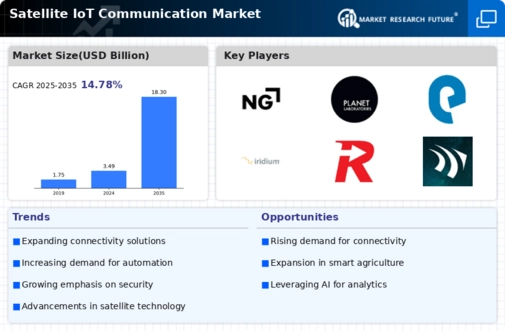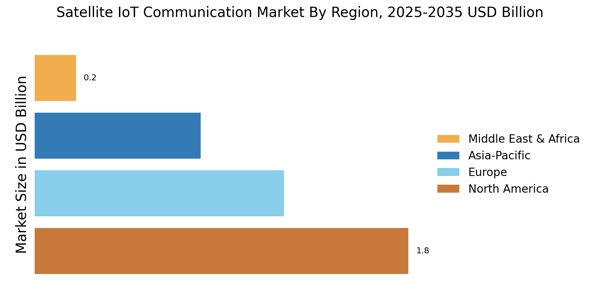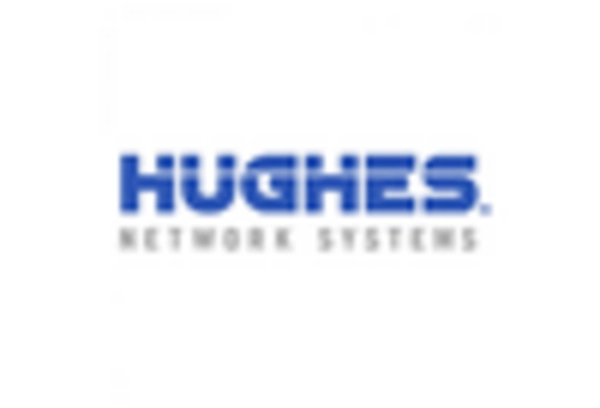Emergence of Smart Cities
The Satellite IoT Communication Market is being propelled by the emergence of smart cities, which leverage advanced technologies to improve urban living. These cities utilize IoT devices for various applications, including traffic management, waste management, and public safety. Satellite communication plays a crucial role in ensuring reliable connectivity for these devices, particularly in areas where terrestrial infrastructure is insufficient. As urban populations continue to grow, the demand for smart city solutions is expected to rise, with investments projected to reach USD 1 trillion by 2030. This trend indicates a substantial opportunity for the Satellite IoT Communication Market to expand its footprint in urban environments.
Increased Focus on Asset Tracking
The Satellite IoT Communication Market is witnessing a surge in demand for asset tracking solutions across various sectors, including logistics, transportation, and supply chain management. Companies are increasingly recognizing the value of real-time tracking of assets to improve operational efficiency and reduce losses. Satellite IoT communication provides a robust solution for tracking assets in remote locations where traditional networks may not be available. The market for asset tracking is projected to grow significantly, with estimates suggesting a value of USD 40 billion by 2027. This growth is likely to be fueled by the need for enhanced visibility and control over assets, thereby propelling the Satellite IoT Communication Market forward.
Expansion of Connectivity Solutions
The Satellite IoT Communication Market is experiencing a notable expansion due to the increasing demand for connectivity solutions in remote and underserved areas. As traditional terrestrial networks often fail to provide adequate coverage, satellite communication emerges as a viable alternative. This trend is particularly evident in sectors such as agriculture, where IoT devices require reliable connectivity for monitoring crop health and soil conditions. The market is projected to grow at a compound annual growth rate of approximately 25% over the next five years, driven by the need for seamless data transmission in challenging environments. Furthermore, advancements in satellite technology, including low Earth orbit (LEO) satellites, are enhancing the capabilities of IoT applications, thereby fostering growth in the Satellite IoT Communication Market.
Rising Adoption of Smart Agriculture
The Satellite IoT Communication Market is significantly influenced by the rising adoption of smart agriculture practices. Farmers are increasingly utilizing IoT devices to monitor soil moisture, weather conditions, and crop health, which necessitates reliable communication channels. Satellite IoT solutions provide the necessary infrastructure to support these applications, especially in rural areas where terrestrial networks are limited. According to recent estimates, the agricultural IoT market is expected to reach USD 20 billion by 2026, with a substantial portion attributed to satellite communication technologies. This trend not only enhances productivity but also promotes sustainable farming practices, thereby driving the growth of the Satellite IoT Communication Market.
Growing Demand for Environmental Monitoring
The Satellite IoT Communication Market is increasingly driven by the growing demand for environmental monitoring solutions. Organizations and governments are recognizing the importance of tracking environmental changes, such as air quality, water levels, and climate patterns. Satellite IoT communication provides a reliable means to collect and transmit data from remote sensors deployed in various ecosystems. The market for environmental monitoring is anticipated to grow significantly, with estimates suggesting a value of USD 15 billion by 2025. This growth is likely to be supported by regulatory requirements and public awareness regarding environmental issues, thereby enhancing the relevance of the Satellite IoT Communication Market.


















Leave a Comment